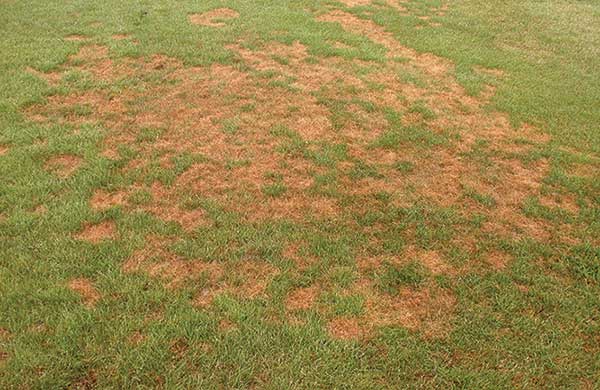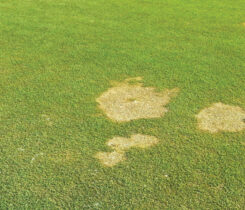Macro-Sorb unveils research of products’ control on turf diseases
Recent academic and independent research shows that various products from Macro-Sorb Technologies help control, reduce and suppress certain turf diseases, Macro-Sorb announced in a news release.
SMS 700 and dry spot
Xi Xiong, Ph.D., associate professor of turfgrass science at the University of Missouri, recently conducted research on SMS 700, a soil surfacant from SMS Additive Solutions, and its control of localized dry spot on creeping bentgrass golf greens and fairways.
“We studied a variety of rates and application timings throughout the summer months on a sand-based USGA-spec creeping bentgrass putting green and native soil creeping bentgrass fairway,” Xiong says. “We concluded that the tested surfactant (SMS 700) improved volumetric water content, reduced localized dry spot, improved turf quality and created a more uniform water distribution in the root-zone.”
The SMS 700 label specifies an initial application of 7 ounces per 1,000 square feet before the onset of localized dry spot, followed by a second 7-ounce application a week later. After 90 days, if further control is needed, another 7-ounce application should be made.
“When golf course greens have hydrophobic soil conditions, water cannot penetrate evenly across the surface and into the soil profile,” says John Haguewood, technical manager for SMS Additive Solutions. “Adding a soil surfactant like SMS 700 helps the water uniformly penetrate and displace through the soil profile and creates a uniform soil moisture.”
Macro-PHITE and Pythium
Independent researcher Steve McDonald of Turfgrass Disease Solutions recently studied Pythium blight development after applications of Macro-Sorb’s Macro-PHITE, a potassium phosphite fertilizer with Macro-Sorb’s amino acid technology, on perennial ryegrass seedlings.
He made three applications of the product at 1 ounce, 1.5 ounces and 2 ounces per 1,000 square feet every 14 days after seedling emergence for a total of four applications. McDonald compared those treatments against a generic potassium phosphite fertilizer currently on the market, as well as Subdue and Banol fungicides.
Results show that the higher rate of Macro-PHITE resulted in less than one percent Pythium and the lowest rate had less than 5 percent Pythium, comparable to the Subdue and Banol plots. The generic phosphite fertilizer treatment — at labeled rate — had 16 percent Pythium, whereas the untreated plot had almost 30 percent Pythium present.
“When applied to turfgrass, the unique complex of amino acids contained in Macro-PHITE boosts the natural defense mechanisms of the plant,” Haguewood says. “The turfgrass plant basically puts up a shield, defending itself from stresses.”
Foliar combined with Proxy/Primo MAXX and Poa seedhead suppression
Jeffrey Borger, senior instructor in turfgrass weed management at Penn State, studied various additives to improve the efficacy of Poa seed head suppression in creeping bentgrass/Poa and 100 percent Poa annua greens. He made two applications spaced two weeks apart of Macro-Sorb Foliar combined with Proxy/Primo MAXX plant growth regulators just prior to seedhead emergence in early spring.
Borger reported a 25 percent increase in seedhead suppression when Macro-Sorb Foliar was tank mixed with Proxy/Primo compared to Proxy/Primo alone. He also made two applications of Macro-Sorb Foliar plus Quelent-Minors combined with Proxy/Primo. Both treatments enhanced turf color, with the second application providing an even darker green-colored turf, according to a press release.
Haguewood noted that Macro-Sorb Foliar enhances uptake of the plant growth regulator products. He added that Quelent-Minors contains iron, manganese and magnesium all nutrients that improve turf color.”The Proxy/Primo application often causes a slight discoloration of turf,” he says. “The addition of Macro-Sorb Foliar and Quelent-Minors reduces that discoloration.”











Sounds interesting. Would like to learn more about this product and other products.